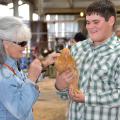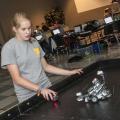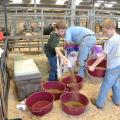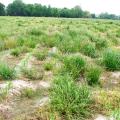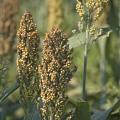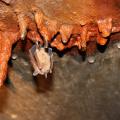News From 2013
JACKSON – After a 30-year absence, the 4-H poultry livestock show returned with great fanfare to the Mississippi State Fair this year.
Jessica Wells, poultry science specialist with the Mississippi State University Extension Service, said the poultry program has been very popular with 4-H’ers since it returned to the program lineup in 2012. She said 150 children participated this year with 64 showing their chickens at the state fair.
MISSISSIPPI STATE – Two Mississippi State University units are helping sponsor a conference for people interested in developing outdoor recreation and tourism businesses.
The MSU Extension Service and Stennis Institute of Government and Community Development are promoting the annual Alabama-Mississippi Rural Tourism Conference Oct. 28-30. The event will be in Guntersville, Ala., and the theme is outdoor recreation.
You probably have figured out by now that I have a lot of favorite plants. Since it’s autumn, I get to talk about one of my favorite native plants that is in its full glory right now.
The American beautyberry is really putting on quite a show in Mississippi with clusters of bright purple berries.
American beautyberry is commonly found on the edges of woodlands all across the state. It is widely found east of the Mississippi in the mid-Atlantic and Gulf Coast region of North America.
By Mary Grace Eppes
MSU Ag Communications
MISSISSIPPI STATE - With the school year well underway, families across Mississippi commonly encounter illnesses, viruses or the contagious and bothersome head lice.
David Shrock, a health education and wellness graduate assistant at Mississippi State University, said the head louse is a parasitic insect that can be found on heads, eyebrows and eyelashes of humans.
BILOXI – Biloxi homeowner Jesse Aguilar got a little help installing a high tunnel in his backyard from two Mississippi State University horticulture scientists and the traveling home improvement show “Ask This Old House.”
MISSISSIPPI STATE -- About 4,000 fourth-graders, teachers and parents from across the state will be at Mississippi State University Oct. 14-18 for the annual Wood Magic Science Fair.
Activities and exhibits illustrating everything from papermaking to the strength of a toothpick-sized piece of wood are part of the annual event at the Forest Products Lab complex during the week.
Sponsored by the university’s College of Forest Resources, the event is designed to illustrate the importance of natural resources throughout the state.
MISSISSIPPI STATE – The cool, damp nights that are making it feel like fall in Mississippi are slowing peanut harvests way down across much of the state.
Mississippi’s peanut crop was 28 percent harvested as of the last U.S. Department of Agriculture Crop Progress and Condition Report released Sept. 30. Because of the federal government shutdown, no new figures have been released in almost two weeks. At the end of September, 48 percent of the crop was listed in good condition, with 13 percent excellent and 39 percent fair.
MISSISSIPPI STATE – Mississippians interested in the state’s latest agricultural news will need to tune in or set their digital video recorders to a different time.
Farmweek, the state’s oldest and only locally produced agricultural television news show, has moved to Saturdays at 6 p.m. and Mondays at 6 a.m. on Mississippi Public Broadcasting. The show also can be seen on the nationwide satellite and cable TV network RFD-TV Fridays at 5 p.m. and on Wednesdays and Saturdays at 3 a.m., or online.
MISSISSIPPI STATE – Mississippi 4-H provides a year-round youth development activity in Mississippi, but it gets an extra share of the spotlight with fall activities that include National 4-H Week Oct. 6-12.
The 4-H Youth Development Program is part of the Mississippi State University Extension Service. This year, it has more than 103,500 members ages 8 to 18 in 1,731 clubs across the state. These groups range from specialized clubs for robotics, horses, shooting sports or outdoor activities, to general interest clubs and after-school programs.
STONEVILLE -- Mississippi State University scientists are leading the charge in the fight against glyphosate-resistant Italian ryegrass with a research-based plan of attack.
Jason Bond, a weed scientist at the MSU Delta Research and Extension Center in Stoneville, said Mississippi was the first state to discover Italian ryegrass that cannot be controlled with glyphosate, a common herbicide originally known as Round-up, in a crop situation. The weed has spread quickly since it arrived.
I have to admit that I’m ready for this hot and really humid Mississippi summer to be over. Even though we are officially in the fall season, those high temps have been lingering into October.
But it seems we may have turned the corner towards lower temperatures. I even slept with the window open recently for the first time since I don’t know when. This means cool-season annuals will soon be showing up.
CHOCTAW – Fruit and vegetable growers can learn the latest tips and techniques at an upcoming conference near Philadelphia.
The Mississippi Fruit and Vegetable Growers Conference and Trade Show will be Nov. 13-15 at the Silver Star Conference Center in Choctaw.
The conference is open to new and experienced growers and other interested individuals. Experts from the Mississippi State University Extension Service and Mississippi Agricultural and Forestry Experiment Station will deliver many of the sessions.
By Kaitlyn Byrne
MSU Ag Communications
MISSISSIPPI STATE -- While hunters may see Mississippi’s 1.75 million white-tailed deer as potential antlers on their walls, many farmers see reduced crop yields instead.
Bronson Strickland, associate Extension professor in the Mississippi State University Department of Wildlife, Fisheries and Aquaculture, said the impact of Mississippi’s deer population varies depending on who is asked.
MISSISSIPPI STATE -- Mississippi’s farmers showed their ability to adapt when wet spring weather forced many of them to change their planting intentions from corn, cotton and soybeans to late-planted grain sorghum.
MISSISSIPPI STATE – When water runs clear and fast from a tap, it’s often hard to believe there could be a challenge for individuals, farmers and communities to keep it clean and plentiful.
Joe Street, associate director of the Mississippi State University Extension Service, warned that water supplies could be depleted, even in the South, where rainfall, rivers, streams and lakes are plentiful. This problem can already be seen in the Mississippi Delta, where producers must drill deeper to tap the Mississippi River Valley’s alluvial aquifer.
MISSISSIPPI STATE – An apparel designer for a prominent national retailer told Mississippi State University students that the clothing industry is a good career choice since about 25 percent of the global economy is involved in it.
Ellen Sheppard is the lead apparel developer for Recreational Equipment Inc., commonly known as REI, and oversees its sportswear collections. She was on campus Oct. 2 and 3 telling students in the MSU School of Human Sciences what it takes to create a successful career in this field.
MISSISSIPPI STATE -- As summer ends and fall begins, homeowners who don’t want host neighbors from the natural world should begin preparing their houses for cooler weather.
Most people think of certain insects and mice as the critters looking for a cozy spot to spend the winter. But as natural habitats decline, bats are also looking for suitable homes.
Bats are nocturnal and prefer to roost in dark places during the day. While they like caves and big, hollow trees, those natural roosts can be hard to find.
Pages
News Types
- Crop Report (424)
- Feature Story (5894)
- Feature Photo (53)
- Extension Outdoors (318)
- Southern Gardening (1457)
- Extension Inbox (95)
Archive
- 2025 (20)
- 2024 (190)
- 2023 (182)
- 2022 (186)
- 2021 (177)
- 2020 (212)
- 2019 (223)
- 2018 (276)
- 2017 (338)
- 2016 (383)
- 2015 (457)
- 2014 (498)
- 2013 (490)
- 2012 (492)
- 2011 (356)
- 2010 (323)
- 2009 (313)
- 2008 (273)
- 2007 (263)
- 2006 (252)
- 2005 (278)
- 2004 (273)
- 2003 (279)
- 2002 (228)
- 2001 (238)
- 2000 (243)
- 1999 (233)
- 1998 (232)
- 1997 (239)
- 1996 (58)
- 1995 (36)

